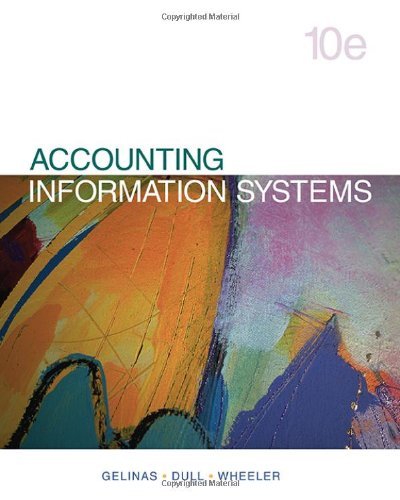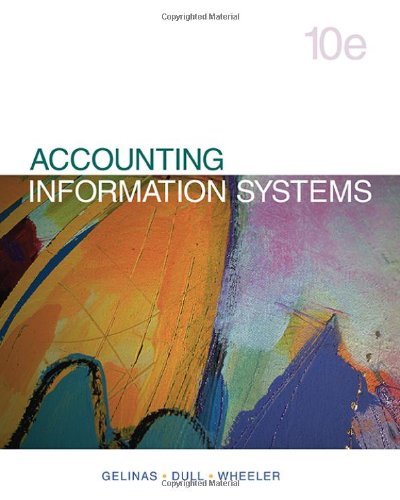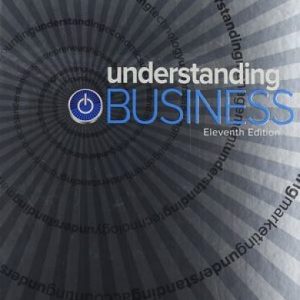This is completed downloadable of Accounting Information System Gelinas Gelinas 10th Edition Solutions Manual

Product Details:
- ISBN-10 : 113393594X
- ISBN-13 : 978-1133935940
- Author:
Users explore today’s most intriguing AIS topics to see how they relate to business processes, information technology, strategic management, security, and internal controls. The text is clearly written to help users grasp even the most challenging topics. ACCOUNTING INFORMATION SYSTEMS, 10E focuses on three critical accounting information systems used today: enterprise systems, e-Business systems, and controls for maintaining those systems. The tenth edition provides users with the necessary tools and processes for organizing and managing information.
Table of Content:
- Part 1: Understanding Information Systems
- Ch 1: Introduction to Accounting Information Systems
- Ch 1: Learning Objectives
- Ch 1: Synopsis
- Ch 1: Introduction
- The Textbook’s Three Themes
- Beyond Debits and Credits
- What Is an Accounting Information System?
- Logical Components of a Business Process
- Management Uses of Information
- The Accountant’s Role in the Current Business Environment
- Ch 1: Summary
- Ch 1: Key Terms
- Ch 1: Review Questions
- Ch 1: Discussion Questions
- Ch 1: Short Problems
- Ch 1: Problems
- Ch 2: Enterprise Systems
- Ch 2: Learning Objectives
- Ch 2: Synopsis
- Ch 2: Introduction
- The Value of Systems Integration
- Enterprise Systems Support for Organizational Processes
- Enterprise Systems Record That Business Events Have Occurred
- Major ERP Modules
- Enterprise Systems Support for Major Business Event Processes
- Ch 2: Summary
- Ch 2: Key Terms
- Ch 2: Review Questions
- Ch 2: Discussion Questions
- Ch 2: Short Problems
- Ch 2: Problems
- Ch 3: Electronic Business (E-Business) Systems
- Ch 3: Learning Objectives
- Ch 3: Synopsis
- Ch 3: Introduction
- Applying E-Business to the Value Chain
- The Changing World of Business Processing
- Methods for Conducting E-Business
- Ch 3: Summary
- Ch 3: Key Terms
- Ch 3: Review Questions
- Ch 3: Discussion Questions
- Ch 3: Short Problems
- Ch 3: Problems
- Part 2: Organizing and Managing Information
- Ch 4: Documenting Information Systems
- Ch 4: Learning Objectives
- Ch 4: Synopsis
- Ch 4: Introduction
- Reading Systems Documentation
- Preparing Systems Documentation
- Documenting Enterprise Systems
- Ch 4: Summary
- Ch 4: Key Terms
- Ch 4: Review Questions
- Ch 4: Discussion Questions
- Ch 4: Short Problems
- Ch 4: Problems
- Ch 5: Database Management Systems
- Ch 5: Learning Objectives
- Ch 5: Synopsis
- Ch 5: Introduction
- Two Approaches to Business Event Processing
- Database Management Systems (DBMSs)
- Database Essentials
- Using Databases and Intelligent Systems to Aid Decision Makers
- Ch 5: Summary
- Ch 5: Key Terms
- Ch 5: Review Questions
- Ch 5: Discussion Questions
- Ch 5: Short Problems
- Ch 5: Problems
- Ch 6: Relational Databases and SQL
- Ch 6: Learning Objectives
- Ch 6: Synopsis
- Ch 6: Introduction
- Business Intelligence (BI)
- REA Modeling
- Relational Databases
- SQL: A Relational Database Query Language
- Ch 6: Summary
- Ch 6: Key Terms
- Ch 6: Review Questions
- Ch 6: Discussion Questions
- Ch 6: Short Problems
- Ch 6: Problems
- Part 3: Enterprise Risk Management
- Ch 7: Controlling Information Systems: Introduction to Enterprise Risk Management and Internal Contr
- Ch 7: Learning Objectives
- Ch 7: Synopsis
- Organizational Governance
- Enterprise Risk Management
- Defining Internal Control
- A Framework for Assessing the Design of a System of Internal Control
- Ch 7: Summary
- Ch 7: Key Terms
- Ch 7: Review Questions
- Ch 7: Discussion Questions
- Ch 7: Short Problems
- Ch 7: Problems
- Ch 8: Controlling Information Systems: Introduction to Pervasive Controls
- Ch 8: Learning Objectives
- Ch 8: Synopsis
- Ch 8: Introduction
- Organizational Design Control Plans
- Personnel Policy Control Plans
- Monitoring Control Plans
- IT General Controls and the COBIT 4.1 Framework
- Plan and Organize Domain
- Acquire and Implement Domain
- Deliver and Support Domain
- Monitor and Evaluate Domain
- COBIT 5
- Ch 8: Summary
- Ch 8: Key Terms
- Ch 8: Review Questions
- Ch 8: Discussion Questions
- Ch 8: Short Problems
- Ch 8: Problems
- Ch 9: Controlling Information Systems: Business Process and Application Controls
- Ch 9: Learning Objectives
- Ch 9: Synopsis
- Ch 9: Introduction
- The Control Framework
- Sample Control Plans for Data Input
- Control Plans for Manual and Automated Data Entry
- Control Plans for Data Entry with Batches
- Ch 9: Summary
- Ch 9: Key Terms
- Appendix 9A: Public Key Cryptography and Digital Signatures
- Ch 9: Review Questions
- Ch 9: Discussion Questions
- Ch 9: Short Problems
- Ch 9: Problems
- Part 4: Business Processes
- Ch 10: The Order Entry/Sales (OE/S) Process
- Ch 10: Learning Objectives
- Ch 10: Synopsis
- Ch 10: Introduction
- Process Definition and Functions
- Organizational Setting
- Physical Description of the OE/S Process
- Application of the Control Framework
- Ch 10: Summary
- Ch 10: Key Terms
- Ch 10: Review Questions
- Ch 10: Discussion Questions
- Ch 10: Short Problems
- Ch 10: Problems
- Ch 11: The Billing/Accounts Receivable/Cash Receipts (B/AR/CR) Process
- Ch 11: Learning Objectives
- Ch 11: Synopsis
- Ch 11: Introduction
- Organizational Setting
- Using Technology to Optimize Cash Resources
- Logical Process Description
- Physical Description of the Billing Process
- Application of the Control Framework for the Billing Process
- Physical Description of the Cash Receipts Process
- Application of the Control Framework for the Cash Receipts Process
- Ch 11: Summary
- Ch 11: Key Terms
- Ch 11: Review Questions
- Ch 11: Discussion Questions
- Ch 11: Short Problems
- Ch 11: Problems
- Ch 12: The Purchasing Process
- Ch 12: Learning Objectives
- Ch 12: Synopsis
- Ch 12: Introduction
- Process Definition and Functions
- Organizational Setting
- Logical Process Description
- Technology Trends and Developments
- Physical Process Description
- Application of the Control Framework to Purchasing
- Ch 12: Summary
- Ch 12: Key Terms
- Ch 12: Review Questions
- Ch 12: Discussion Questions
- Ch 12: Short Problems
- Ch 12: Problems
- Ch 13: The Accounts Payable/Cash Disbursements (AP/CD) Process
- Ch 13: Learning Objectives
- Ch 13: Synopsis
- Ch 13: Introduction
- Process Definition and Functions
- Organizational Setting
- Logical Process Description
- Technology Trends and Developments
- Physical Process Description
- Application of the Control Framework
- Ch 13: Summary
- Ch 13: Key Terms
- Ch 13: Review Questions
- Ch 13: Discussion Questions
- Ch 13: Short Problems
- Ch 13: Problems
- Ch 14: The Human Resources (HR) Management and Payroll Processes
- Ch 14: Learning Objectives
- Ch 14: Synopsis
- Ch 14: Introduction
- Process Definition and Functions
- The HR Management Process
- The Payroll Process
- Ch 14: Summary
- Ch 14: Key Terms
- Ch 14: Review Questions
- Ch 14: Discussion Questions
- Ch 14: Short Problems
- Ch 14: Problems
- Ch 15: Integrated Production Processes (IPPs)
- Ch 15: Learning Objectives
- Ch 15: Synopsis
- Competing in a Global Manufacturing Environment
- Integrated Production Processes (IPPs)
- Cost Accounting: Variance Analysis
- Inventory Management
- Ch 15: Summary
- Ch 15: Key Terms
- Ch 15: Review Questions
- Ch 15: Discussion Questions
- Ch 15: Short Problems
- Ch 15: Problems
- Part 5: Reporting
- Ch 16: The General Ledger and Business Reporting (GL/BR) Process
- Ch 16: Learning Objectives
- Ch 16: Synopsis
- System Definition and Functions
- Organizational Setting
- Logical System Description
- Technology-Enabled Initiatives and the Reporting Environment
- Ch 16: Summary
- Ch 16: Key Terms
- Ch 16: Review Questions
- Ch 16: Discussion Questions
- Ch 16: Short Problems
- Ch 16: Problems
- Part 6: Acquiring an AIS
- Ch 17: Acquiring and Implementing Accounting Information Systems
- Ch 17: Learning Objectives
- Ch 17: Synopsis
- Ch 17: Introduction
- Acquiring an AIS from External Parties
- Managing the Systems Development Process
- Systems Development Methodology
- Step 1: Systems Survey
- Step 2: Structured Systems Analysis
- Step 3: Systems Selection
- Step 4: Structured Systems Design
- Step 5: Systems Implementation
- Step 6: Post-Implementation Review
- Step 7: Systems Maintenance
- Accountant Involvement in AIS Acquisition/Development and Implementation
- Ch 17: Summary
- Ch 17: Key Terms
- Ch 17: Review Questions
- Ch 17: Discussion Questions
- Ch 17: Short Problems
- Ch 17: Problems
- Glossary
- Index





